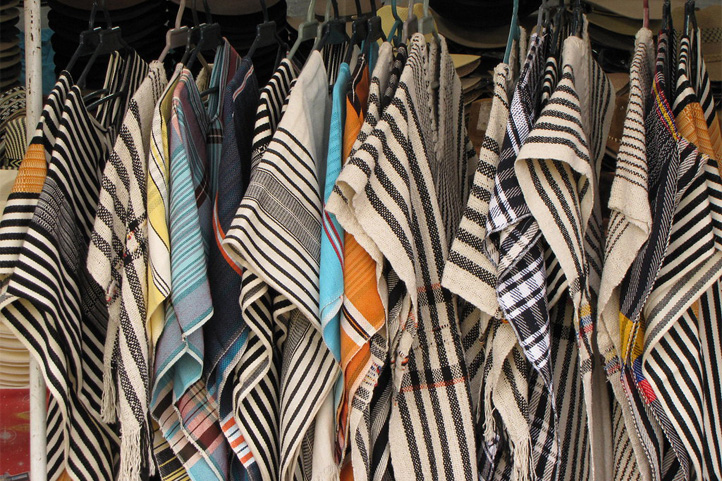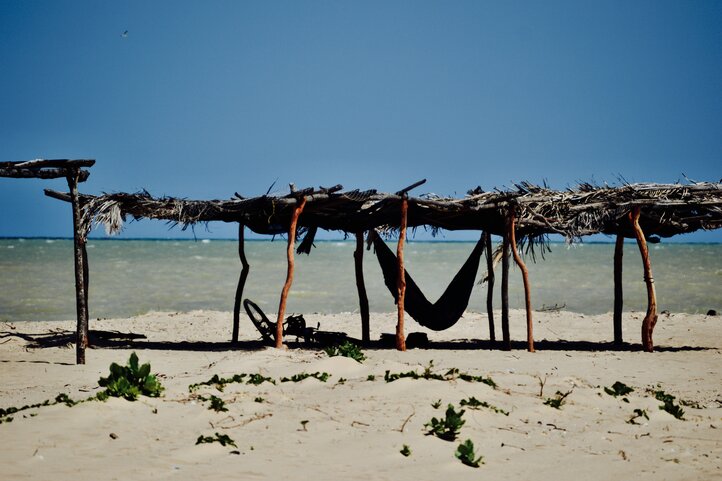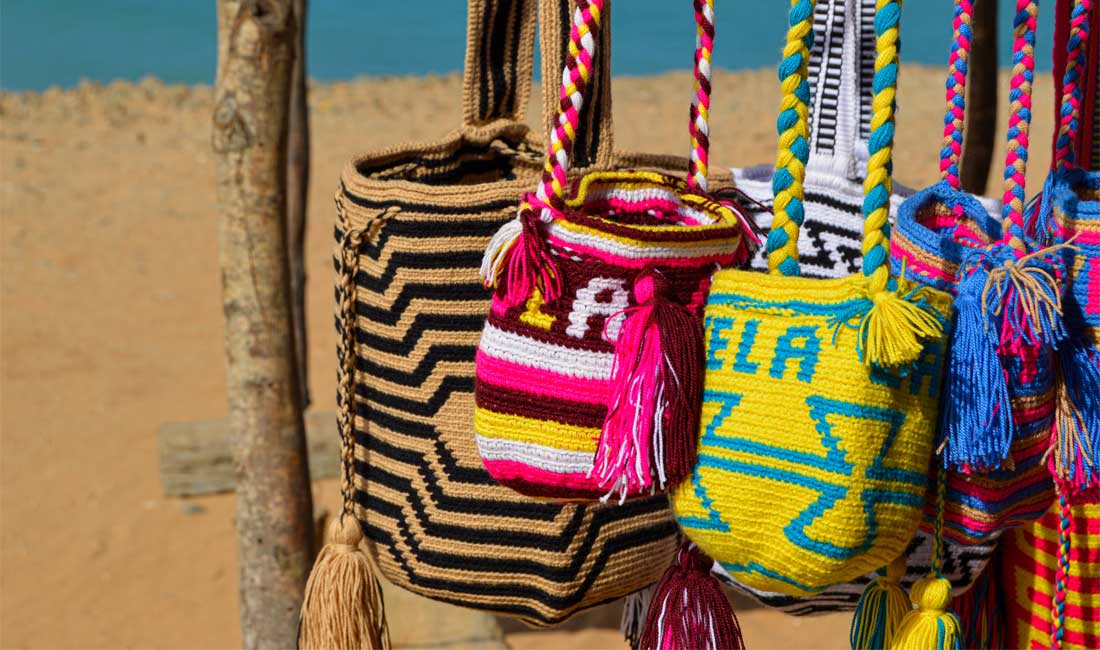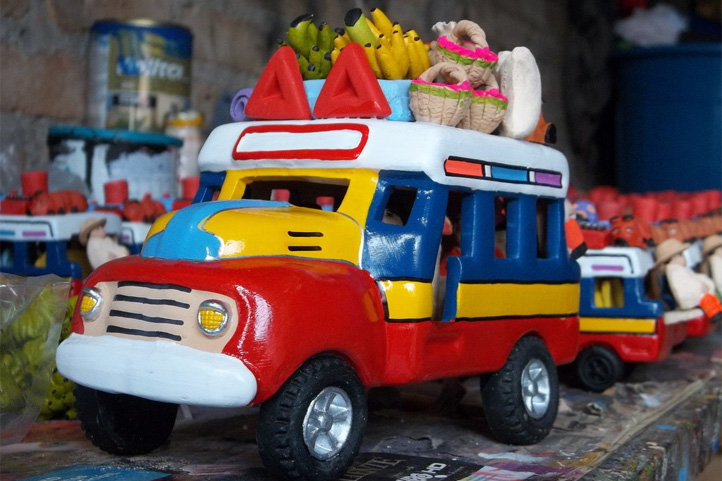Updated on 04/22/2024
Dear reader,
I would also like to recommend our Colombia travel guide, which provides a perfect overview of the tourist attractions in Colombia. Enjoy reading it!
Did you know that the handicraft industry in Colombia accounts for 15% of the country’s manufacturing sector and generates profitability, attracting numerous foreign investors? In this blog, we’ll take you on a tour of the most popular and best-selling Colombian handicrafts that you might not have known about.
Content
ToggleThe Sombrero Vueltiao (Vueltiao Hat)
The Sombrero Vueltiao is more Colombian than a morning tinto. It’s a masterpiece from the Colombian Caribbean region, specifically from the department of Córdoba.
Its most distinctive feature is its spiral weaving, giving it a visual appearance of constant movement, a sort of whirlwind. You might have seen it in TV series or movies; perhaps it’s the most popular craft of the country.
- The Sombrero Vueltiao is a decorative garment of indigenous origin (Zenúes) made with fibers from the caña flecha plant, native to the Colombian Caribbean, and it’s estimated to be over a thousand years old.
- It’s called vueltiao because it’s woven in a circular shape, spinning the fiber. The number of turns determines its quality. The finest ones can have up to 31 turns, while the most common ones range between 19 and 23.
- The designs represent elements of Zenú culture such as animals, plants, beliefs, and other elements of Caribbean nature or culture.
- It has its own day on the national calendar. Every June 18th, the Day of the Sombrero Vueltiao is celebrated, becoming a cultural symbol of the country.
The Ruana
It’s a large and thick woolen blanket designed with a hole cut in the middle for the head to pass through. It has a square or rectangular shape and originates from the Cundiboyacense highlands (Boyacá and Cundinamarca).
They are generally worn over clothes. It’s one of the most popular and distinctive crafts of Colombia.

- The ruana is a garment of indigenous origin, believed to have been inspired by the cloaks worn by the Spanish during the conquest. It’s also said that the name comes from the cloths that the Spanish imported from Rouen, France.
- It’s made with 100% virgin wool. To make just one, wool from only 2 large sheep is needed. The process includes shearing, washing, spinning, dyeing, and weaving the wool.
- It’s a symbol of the Andean region of Colombia. Furthermore, in Boyacá, World Ruana Day is celebrated in the municipality of Nobsa, where you can find the best ruanas, and they are exported.
- The ruana has been used by King Charles of England and Pope John Paul II during his visit to Colombia.
- It serves as a decorative object for the sofa, as a rug, as a blanket. You can find many uses for it.
The Chinchorro
The Chinchorro is a kind of hammock that hangs from ends, but it’s made of perforated nylon or thin thread fabric. It’s woven by Wayúu indigenous women in the department of La Guajira, in northern Colombia.
Basically, it’s used for resting and sleeping, especially in hot climates. This craft has been deeply rooted in Colombian culture for centuries and is quite popular.

- It’s one of the most expensive crafts because it requires meticulous handwork and takes between two to six months to complete.
- The largest chinchorros you can find measure up to 4 meters from end to end and weigh over 6 kilograms; some come with a double layer and protect against the cold.
- In Wayúu culture, this object is part of the marriage tradition, as the groom’s family delivers it to the bride’s family as a union of the couple, as well as the home to be formed.
- In Wayúu culture, it’s also a piece of furniture to receive visitors, talk with close relatives, and even as a shroud, to wrap the deceased.
The Alpargatas (Espadrilles)
Espadrilles are traditional footwear or a type of slipper made with jute soles, a vegetable fiber extracted from a plant. It also carries regional weavings with fique, another vegetable fiber. It’s used in the Andean region of Colombia, as well as in other regions of the country, quite popular indeed.
- Espadrilles are biodegradable, as they are made of plant fibers that degrade naturally. This contributes to the environment and the reduction of ecological footprint.
- They are often showcased at fashion events and craft fairs, which has made them quite popular nationally and internationally.
- You’ll find designs inspired by the country’s regions: Amazon, Caribbean, Pacific, Andean, Orinoquia, and Insular.
- They are very versatile and comfortable for every occasion, from everyday use for beach and summer environments to much colder climates.
The Wayúu Backpack
The Wayúu backpack is a handmade bag made with wool or cotton by the Wayúu indigenous community, also made by women, and they often feature many colors and symbols.
It’s another of the best-selling Colombian handicrafts today. However, you must be careful not to buy generic backpacks, as it does not benefit the indigenous communities that make them.

- Each backpack is unique and represents the creativity and personality of the woman who weaves it. They have a symbolic meaning and reflect nature, animals, plants, stars, and ideals of the weaver.
- It’s manufactured using the crochet technique, an ancestral technique for forming chains with threads of wild cotton using only a hook. The process is complex and takes between 20 and 30 days to finish the backpack.
- These bags are very resistant and versatile. They can be used as handbags, shoulder bags, or backpacks, adapting to all looks and styles.
- After the arrival of the Spaniards and thanks to their influence, they began to use acrylic threads of different colors.
- Before colonization, the Wayúu started using larger bags, where they carried merchandise to trade such as textiles, fruit, food, among others.
The Mud Chiva
The mud chiva is a lively representation of the Colombian chiva, a very colorful means of transportation, typical of the Andean regions, which originated over 100 years ago in the department of Antioquia.

- The first mud chiva was inspired by the colorful buses that transported people and goods through rural areas of Colombia.
- The mud chiva is one of the most popular and recognized crafts of Colombia, so much so that it’s considered a cultural symbol of the country. Mud chivas began to be manufactured in the municipality of Pitalito in Huila and obtained a certified designation of origin by the Superintendence of Industry and Commerce.
- The mud chiva is a craft that reflects the personality and style of its creator; each mud chiva is unique.
- It’s a craft that has become a collectible and gift item for tourists and foreigners visiting or living in the country.
- The chiva is currently the most representative bus in the country. It is still used for tourist purposes and to carry out mobile parties through towns and cities.
The Ceramics of Ráquira
The ceramics of Ráquira are iconic in the country. Ráquira is a municipality in Boyacá known for its production of pottery and artisan ceramics. So much so, that it’s known as the craft capital of Colombia.
You just need to know that it has a very strong indigenous past and was well-known for its clay objects.

- Ráquira ceramics are made with red, purple, and white clays extracted from the municipality’s soil. They are mixed with water, molded by hand, and fired at high temperatures.
- These crafts have a designation of origin that protects them from counterfeiting. It was granted by the Superintendence of Industry and Commerce of Colombia. This recognizes the quality of Ráquira’s artisanal products.
- Ráquira ceramics have many purposes. From pots, plates, vases, flowerpots, animal figures, houses, churches, and other typical motifs of the beliefs of the Muisca.
- They are exported to frequent destinations such as the United States, Spain, France, Germany, Italy, Japan, and Mexico.
- Ráquira ceramic crafts are identified because they have a glaze that gives them protection and durability, making them look shiny or in various colors.
Mopa Mopa Resin – Pasto Varnish
Pasto varnish is a traditional craft technique native to the Colombian Amazon that involves decorating wooden objects with Mopa Mopa sheets, a resin from the “Mopa Mopa” tree native to the Putumayo department, which are dyed in different colors.
- Each piece created with Mopa Mopa is unique. The combination of carving and varnishing means that there are no two exactly alike; each one is a different artisan jewel.
- It’s a craft technique of pre-Hispanic origin that has been preserved for more than 500 years in the city of Pasto in the department of Nariño.
- Pasto varnish was declared Intangible Cultural Heritage of Humanity by UNESCO on December 15, 2020, due to its artistic, historical, and symbolic value.
- It’s applied on different objects such as trays, chests, mirrors, frames, boxes, clocks, jewelry, among others.
- It’s characterized by its geometric and figurative designs that represent the worldview, nature, religion, and daily life of the region’s inhabitants.
Jewelry from Mompox
Santa Cruz de Mompox is a place located in the department of Bolívar and is so special that even UNESCO decided to name it Cultural Heritage of Humanity in 1995.
In addition to being historically important, it’s considered the country’s main goldsmith center. Its technique in jewelry craftsmanship is recognized not only in Colombia but also in different parts of the world.
- They are very fine designs mainly in gold or silver. These materials are rolled and soldered to create perfect geometric figures sometimes combined with gems and precious stones.
- Like Ráquira crafts, Mompox jewelry received a designation of origin, which protects them from piracy, unfair competition, and credits them as authentic.
- Some pieces such as earrings, rings, bracelets, necklaces, and ear cuffs are inspired by biodiversity and religion such as plants, animals, saints, and crosses. Customers can also customize to their liking.
- Mompox jewelry is considered an excellent investment in precious metals, as the gold and silver extracted from this place are materials that retain their value and beauty over time.
- The quality of Mompox jewelry has been internationally known and attracts thousands of tourists, investors, and collectors every year.
- Some iconic figures in the international arena have been seen wearing these jewels, such as Michelle Obama or when the Presidency of the Republic commissioned a filigree bag for Queen Elizabeth II of England.
Where to Buy Handicrafts in Colombia?
In the most touristy places, whether in towns or cities in Colombia, you’ll always find handicrafts. Additionally, annual events are also held in some major cities of the country, where you can find crafts from all regions of the country in one place:
Expoartesanias – Bogotá, Colombia
Expoartesanias is the largest handicraft fair in Latin America, aiming to conserve crafts and traditions with the participation of over 700 artisans from across the country. You’ll find categories like home decor, fashion, jewelry, instruments, tableware, and kitchenware, among others. Moreover, it’s a significant meeting point for investors from various parts of the world.
Access: Admission fee required.
Duration: Around 15 days, usually in December.
Location: Carrera 37 # 24-37, Corferias, Bogotá, Colombia.
Number of attendees: 70,000 people per edition.
For more information, you can explore further offers at Expoartesanias.
Expoartesano – Medellín, Antioquia
Expoartesano is a craft fair featuring over 450 exhibitors and artisans. Here, you can enjoy the best craft showcases the country has to offer. Once you enter, you’ll realize it’s an important means of preserving Colombia’s indigenous and Afro-descendant culture.
Access: Admission fee required.
Duration: 10 days, usually in July, though the month may vary each year.
Location: Calle 41 # 50-80, Plaza Mayor Medellín, Medellín, Antioquia.
Number of attendees: Over 25,000 people per edition.
We invite you to visit Expoartesano for more information and stay updated on the latest developments.
Farex – Cartagena, Bolívar
Farex is the most important fair in the Caribbean, featuring over 250 exhibitors in the fields of crafts, design, fashion, and art. Here, you’ll not only find high-quality products but also have face-to-face interactions with each of the artisans. The country’s cultural diversity will be on full display at this event.
Access: Admission fee required.
Duration: Around one week, usually in January.
Location: Calle 24 # 8ª- 344, Barrio Getsemaní, Centro de Convenciones, Cartagena de Indias, Bolívar.
Number of attendees: Over 30,000 people per edition.
If you’re interested, visit Farex so you don’t miss out on anything in the upcoming editions.
More about Colombia Culture and Events
Explore Colombia’s culture by browsing our blogs.
- The 45 Best and Biggest Festivals in Colombia
- What Language is Spoken in Colombia? – Colombian Language Guide
- Colombian Dialects and Jargons – Guide to Colombian Words for Foreigners
- 31 Typical Colombian Dishes from All Regions You Should Try
- Discover What is the Main Religion in Colombia and its Cultural Impact
- How Easter is Celebrated in Colombia: Traditions and Emblematic Destinations
- Guide to Visiting Churches in Colombia: Manners and Tips for Tourists
- 28 Colombian Brands You Should Know When Visiting Colombia
- The Scariest Places You Can Find in Colombia
- The 7 Most Terrifying Legends in Colombia
- 5 Incredible Indigenous Communities Still Existing in Colombia
- 17 Master Colombian Artisans You Must Know
- Top 9 Colombian Handicrafts You Must Have on Your Gift List
- Top 9 UNESCO World Heritage Sites in Colombia
- Curious Facts about the 14 Most Important Monuments in Colombia
- Top 12 Most Important Olympic Athletes in Colombia
- Top 10 Colombia Travel Influencers to Follow on Networks
- 24 Powerful Colombian Natural Remedies for Common Ailments
- How is New Year’s Eve Celebrated in Colombia? 15 Traditions You Should Know
- Guide to Colombian Manners and Etiquette Rules for Foreigners in Colombia
- All About Graffiti and Urban Art in Colombia

